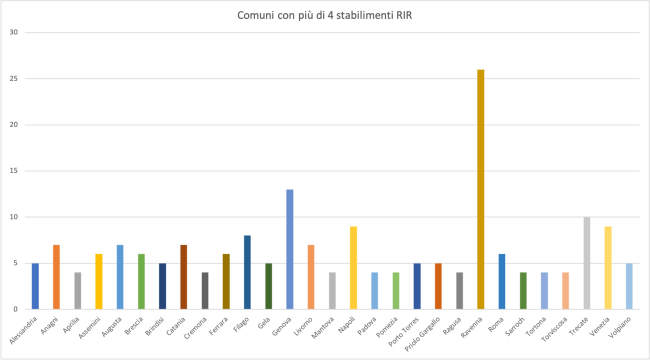Panel 1
Fabrizio Vazzana, Francesca Pepe
The indicator makes it possible to identify areas with a particular concentration of establishments at risk of major accidents, providing useful information for land-use planning, especially for land allocation and utilization. In 2025, there are 29 municipalities with 4 or more RIR (Major Accident Risk) establishments, distributed across 12 regions: they host about one-quarter of all major accident risk establishments in Italy. The regions with the highest number of these municipalities are: Sicily (5), Lazio (4), Lombardy (4), and Piedmont (4). Among the municipalities with a high number of establishments are Ravenna with 26, Genoa with 13, followed by Trecate with 10, Naples and Venice with 9, Filago with 8, and Augusta, Anagni, Catania, and Livorno with 7 each.
The indicator provides a list of municipalities where establishments with a major accident hazard subject to notification (lower-tier and upper-tier establishments) are located, as well as the number of establishments present in each municipality. This indicator narrows the scope of the analysis by taking a smaller territorial unit—namely, the municipality—rather than the region or province. Analyzing this indicator allows for further insights into the map of major accident hazards in our country. In fact, this information makes it possible to more clearly highlight, at the municipal level, areas with a particularly high concentration of establishments at risk of major accidents.
The presence of an establishment with a major accident hazard in a municipality also influences territorial planning, particularly the zoning and use of land. It is necessary to maintain appropriate safety distances between establishments with a Major Accident Risk (MAR) and surrounding residential and commercial areas (Article 22 of Legislative Decree 105/15).
To provide elements for identifying areas with a high concentration of establishments at risk of major accidents across the national territory.
Identification of areas with a high concentration of industrial establishments at risk of major accidents pursuant to Articles 19 and 22 of Legislative Decree 105/2015.
Panel 2
Ispra -Mase, Inventory Seveso Ispra, Annuario of environmental data - several years
It depends on the timeliness and accuracy of the information provided to ISPRA by the operators, which are now subject to a validation process before approval.
None
Data quality assessment
ISPRA (Italian Institute for Environmental Protection and Research)
MASE (Ministry of Environment and Energy Security)
All information comes from the National Inventory of Establishments Susceptible to Causing Major Accidents, as provided for in Article 5, paragraph 3 of Legislative Decree 105/2015 https://www.rischioindustriale.isprambiente.gov.it/seveso-query-105/Default.php
Regional, provincial, municipal
2023-2025
Indicator assessment
All information is taken from the National Inventory of Establishments Susceptible to Causing Major Accidents, as provided for in Article 5, paragraph 3 of Legislative Decree 105/2015. The inventory allows the extraction of an Excel file, from which, after several processing steps, the data necessary for updating the indicator can be obtained.
As of June 30, 2025, there are 29 municipalities with 4 or more MAR (Major Accident Risk) establishments, distributed across 12 regions; these municipalities host approximately one-quarter of all major accident risk establishments in Italy. The regions with the highest number of such municipalities are Sicily (5 municipalities), Lazio (4 municipalities), Lombardy (4 municipalities), and Piedmont (4 municipalities). Among the municipalities with a high number of establishments, Ravenna has 26, Genova 13, followed by Trecate with 10, Napoli and Venezia with 9, Filago with 8, and Augusta, Anagni, Catania, and Livorno with 7 establishments each.
Compared to the previous assessment period (December 2024), the number of municipalities with at least 4 MAR (Major Accident Risk) establishments has remained unchanged, and there have been no significant changes in the number or type of industries subject to the obligations imposed by the 'Seveso' legislation. There are 193 establishments, the same number as in the previous semester.

The choice of the threshold value of 4 establishments was made for practical reasons and does not imply any specific regulatory guidance regarding the criteria for identifying areas with a high concentration of establishments at risk of major accidents. The available data include, in addition to the names of the municipalities, the number of establishments in each of the selected municipalities. Analyzing the indicator allows for further insights into the map of major accident hazards in our country. In fact, this information makes it possible to more clearly highlight, at the municipal level, areas with a particularly high concentration of establishments at risk of major accidents (Figure 1).